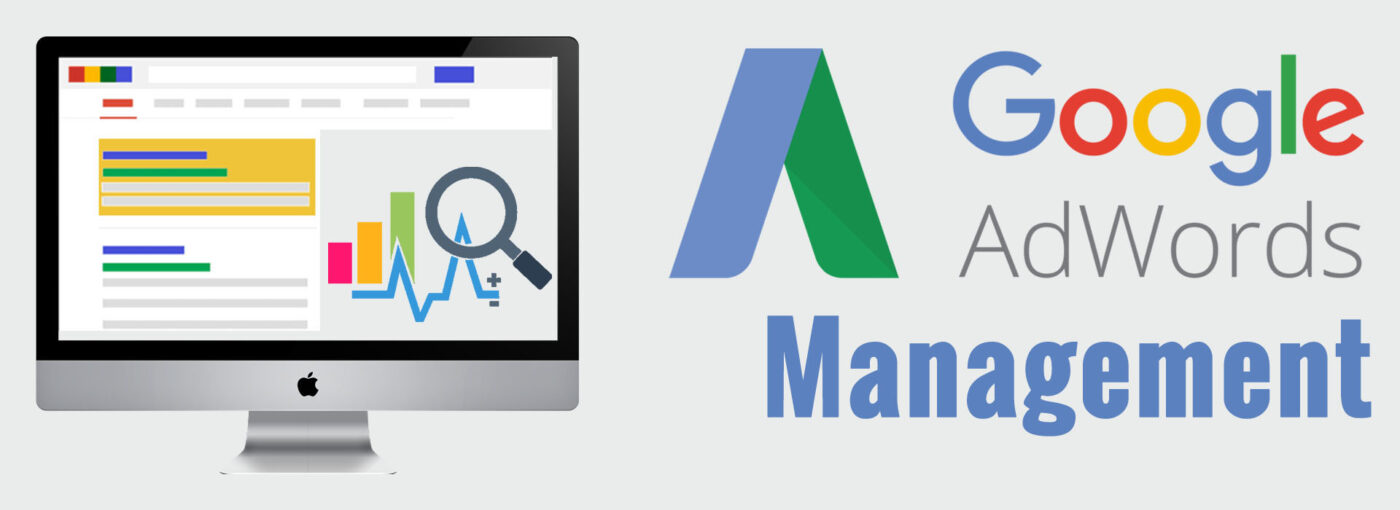Pittsburgh PA Google Adwords Ads PPC Management Agency
Digital advertising has become essential for brands to tell their stories and reach larger audiences in real-time. Marketers can effectively promote their messages and offerings with digital tools and ads across various channels.
Our agency provides customized Google Ads management services to meet each client’s specific needs and goals. Our campaigns are data-driven, informed by market trends, competitor analysis, and an understanding of our clients’ businesses.
Our Google Ads Management Services
We offer a full range of up-to-date Pay Per Click services to boost your digital advertising success:
- Paid Search Advertising – We use relevant, high-performing keywords so your ads appear when customers search for products or services like yours.
- Video Advertising – We help you create and optimize YouTube video ads to engage your target audience.
- Display Advertising – We design compelling display ads and place them on websites, apps, and social platforms to reach more potential customers.
- PPC Remarketing – We show your ads to previous site visitors to remind them about your brand and offerings.
- Social Advertising – We help you advertise on social platforms like Facebook, Instagram, and Twitter to get your brand seen by relevant audiences.
Our Google Ads experts tailor these services to meet your unique business goals and drive accurate results for your marketing budget.
Google Ads Desktop Conversion Rates
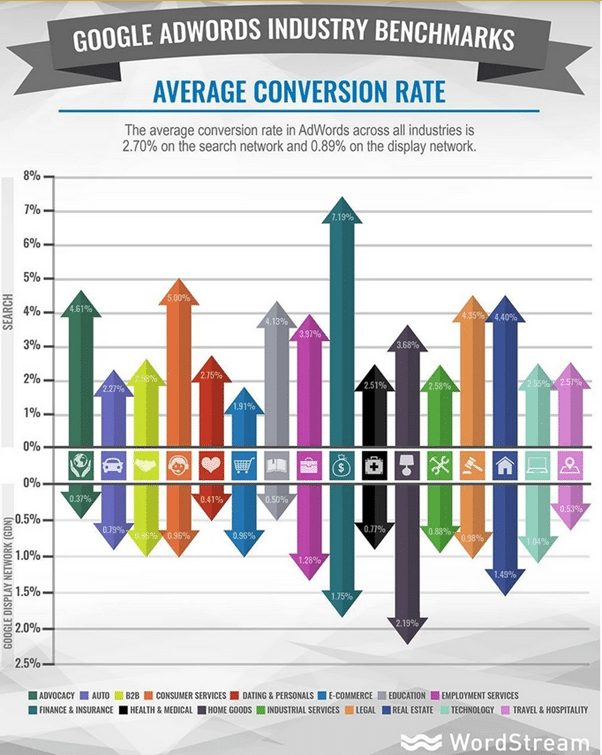
The average conversion rate for Google Ads campaigns targeted to desktop users in 2023 is 7.04%. For every 100 clicks from desktop search ads, an average of 7 conversions occur.
However, conversion rates vary significantly based on factors like industry, target audience, ad quality, and landing page optimization.
Some industries with the highest desktop conversion rates include:
- B2B: 3.04%
- Consumer Services: 6.64%
- Dating and Personals: 9.64%
- E-commerce: 2.81%
Industries with lower desktop conversion rates include:
- Apparel, Fashion and Jewelry: 1.57%
- Furniture: 2.57%
- Real Estate: 2.88%
Conversion rates directly correlate with purchase cycles. Complex B2B sales take longer, while impulse-buy products convert swiftly.
Audience Targeting
Ads matching searches perfectly aligned with products/services outconvert misaligned targeting. Conversion rates directly correlate with relevance quality.
Ad Messaging
Well-written ads articulating value propositions and calls-to-action improve performance over vague branding alone. Testing ad copy and sending top performers to more valuable traffic optimizes conversions.
Landing Pages
Conversion-focused landing pages beat generic homepages. Clear calls-to-action, persuasive messaging, ample conversion paths, and frictionless flows improve conversions over poor page experiences.
Analytics-Based Optimization
Constant campaign fine-tuning based on performance data opens opportunities missed in averages and isolates issues early.
Work with our Google Ads specialists to benchmark desktop conversion rates, identify optimization areas, and maximize the results from search campaigns.
Google Ads Mobile Conversion Rates
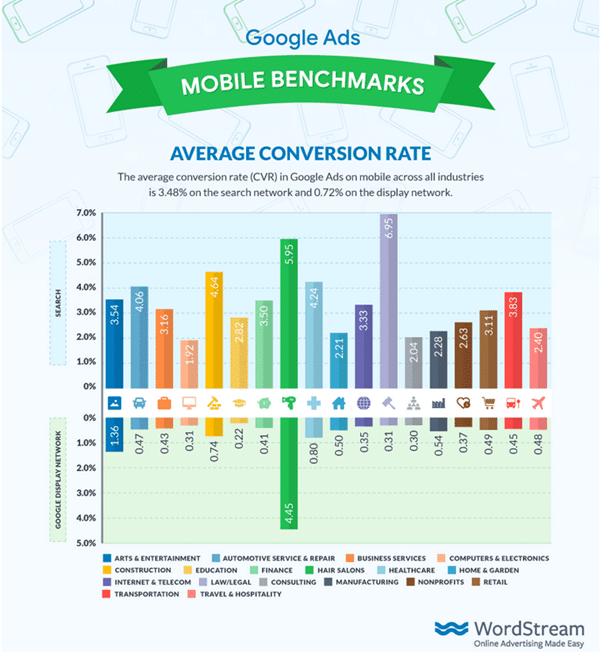
The average mobile conversion rate for Google Ads in 2023 is 3.48% on the search network and 0.72% on the display network. This means for every 100 clicks from mobile search ads, about 3 conversions occur, while for display ads the rate is lower at around 0.72 conversions per 100 clicks.
However, actual mobile conversion rates vary significantly based on factors like:
- Industry vertical
- Type of product/service
- Target audience demographics
- Ad relevance
- Mobile optimization level of landing pages
Some industries with the highest mobile conversion rates include:
- Law/Legal Services: 6.95%
- Construction: 4.64%
- Travel: 4.44%
- Automotive: 3.82%
Industries with lower mobile conversion rates include:
- Education: 2.82%
- Electronics: 2.62%
- Business Consulting: 2.52%
There are several strategies that can help improve Google Ads mobile conversion rates:
- Use mobile-specific ad formats like expanded text ads
- Optimize landing pages for mobile with clear CTAs
- Create dedicated mobile campaigns with mobile-optimized bidding
- Target ads based on mobile-friendly audience signals
- Implement tracking for app conversions
- Test ad variations and landing pages optimized for mobile
- Analyze mobile performance metrics to identify optimization opportunities
Our team can conduct a comprehensive audit of your mobile campaigns to provide specific recommendations tailored to your business and target audience. This includes optimizing campaign elements for each stage of the mobile user journey to drive more conversions.
With the right mobile optimization strategy, you can significantly increase conversions and ROI from your Google Ads investment. Our experts can help make that happen.
Google Ads Average Click-Through Rates

The average click-through rate (CTR) for Google Ads campaigns in 2023 is around 2% on the search network and 0.35% on the display network.
This means for every 100 impressions on search ads, an average of 2 clicks occur. And for the display network, there are 0.35 clicks for every 100 impressions.
However, average CTR varies significantly based on factors like:
- Industry vertical
- Type of product/service
- Ad relevance
- Keyword competitiveness
- Ad extensions used
- Ad position on page
- Landing page quality
Some industries with the highest average CTRs include:
- Legal Services: 4.2%
- Finance: 3.8%
- Travel: 3.7%
- Real Estate: 3.5%
Industries with lower average CTRs include:
- Technology: 1.8%
- Consumer Goods: 1.9%
- Healthcare: 2%
To improve your Google Ads CTR, focus on:
- Using tightly targeted, relevant keywords
- Writing compelling, benefit-focused ad copy
- Adding ad extensions like callouts and site links
- Creating ads tailored to different audiences and devices
- Designing ads to complement the landing page
- A/B testing different ad elements like headlines
- Monitoring search query and ad placement reports to optimize targeting
- Pruning low performing keywords over time
Additionally, when setting CTR goals consider:
- Your industry benchmarks
- Level of keyword competitiveness
- How relevant your offerings are to searchers
- Your daily budget constraints
- The quality score of your existing ads
Our Google Ads specialists can conduct a full audit of your account and provide data-driven recommendations to improve CTRs across your campaigns. With optimized targeting and messaging, we can help you meet your CTR goals and drive more clicks.
Average Cost-Per-Click
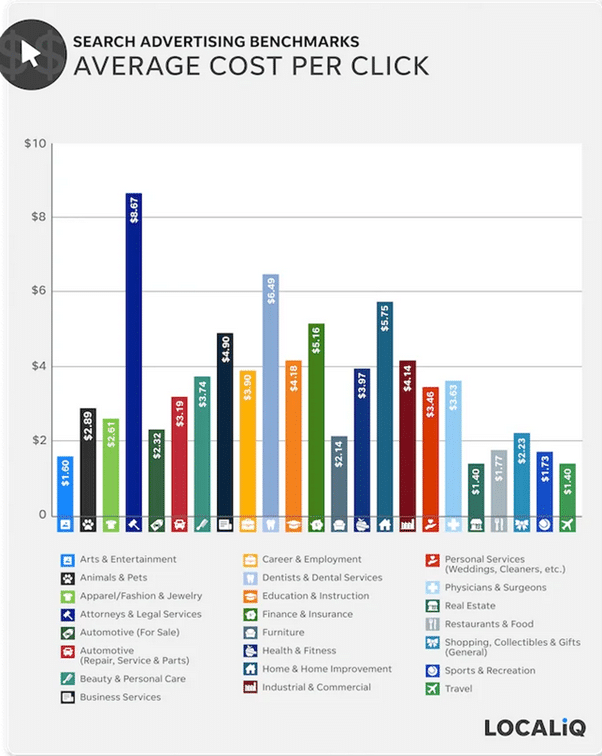
The average cost-per-click (CPC) in Google Ads varies significantly based on factors like:
- Industry vertical
- Audience targeting
- Ad relevance
- Keyword competitiveness
- Campaign budget
On the Search Network, average CPC ranges from $1-2. The Display Network sees lower averages under $1. However, very competitive keywords can lead to much higher CPCs – for example, “lawyer” keywords have $6+ average CPCs.
For new campaigns, start with lower CPC bids and adjust upwards slowly as you gather performance data. Keyword Planner provides average CPC estimates to assist with initial budget planning.
Tips to help reduce CPCs include:
- Choosing product/service-relevant keywords with naturally lower competition
- Writing compelling ads that lead to higher Quality Scores
- Using negative keywords to avoid irrelevant queries
- Implementing ad extensions like callouts and site links
Regularly monitor CPC over time, optimizing for conversions rather than strictly lowering cost. The optimal CPC level depends on campaign goals, target return on ad spend, and other factors.
Complementary Google Ads Formats
In addition to standard search campaigns, we leverage various other Google Ads options as part of comprehensive strategies:
Search Network Campaigns
Our foundation is search campaigns focused on capturing users with immediate purchase intent:
- Keywords are carefully matched to products, services, and conversion goals
- Ads shown prominently above organic results target high relevancy searches
- Landing pages optimized to convert visitors into leads and customers
Search Network campaigns align ads with consumer intent at the critical final research and decision making stage.
Video Advertising Campaigns
We produce and distribute custom video ads across YouTube and the Google Display Network:
- Product demo videos demonstrate usage and advantages
- Brand videos make emotional connections and highlight values
- Testimonial compilation videos socially validate offerings
Video’s sight, sound and motion create engaging experiences, conveying more information and emotion. Views and watch time metrics gauge interest levels.
Display Advertising Campaigns
Display campaigns blanket websites, apps and YouTube channels:
- Visual designs catch user attention, communicating brand image
- Ads link to relevant products, promotions and conversions
- Retargeting keeps messaging top-of-mind with previous visitors
Display ads drive brand lift by putting messaging in front of more audiences where purchasing intent may be lower.
Remarketing Campaigns
We remind and motivate previous visitors across Google’s ecosystem:
- Search ads target return visitors with related purchase intent
- YouTube and Gmail ads follow past visitors analyzing options
- Dynamic customized messaging speaks directly to initial interests
Remarketing campaigns cost-effectively retain potential customers as they evaluate options and move towards decisions.
This diversified Google Ads approach utilizes multiple formats to:
- Attract broad awareness
- Capture initial interest
- Facilitate ongoing research
- Motivate final conversion
Becoming a Google Ads Expert
We stay at the cutting edge of Google Ads capabilities to maximize campaign performance for clients. Mastery of this ever-evolving platform requires an ongoing commitment to hands-on experience and continuing education.
Our Google Ads Certification Process
The Google Ads certification process is a comprehensive journey undertaken by our team to achieve expertise in online advertising through Google’s powerful platform. This involves a structured curriculum covering fundamental concepts, practical skills, utilization of product resources, advanced proficiencies, staying current with new releases, and continual optimization.
1. Learn Fundamentals
- Campaign hierarchy of accounts, ad groups and ads
- Various campaign types like Search, Display and Video
- Keyword matching options and target metrics
2. Gain Practical Skills
- Establishing accounts, building campaigns from scratch
- Testing ad variations, placements and bid strategies
- Evaluating analytics to optimize performance
3. Master Product Resources
- Complete skillshop training programs
- Consume guides and resources in the Google Ads help center
4. Upgrade Advanced Proficiencies
- Graduate certificates in specialized focuses like video, shopping and analytics
- Additional tools, features and beta offerings
5. Stay Current with New Releases
- Active engagement tracking the latest announcements
- Early adoption and experimentation
6. Continual Optimization
- Review analytics dashboards and drive decisions from the data -course correct and capitalize on new opportunities
We don’t rest on our Google Ads expertise – because mastery requires being both individually certified and collectively focused on staying two steps ahead.
Frequently Asked Questions (FAQs)
1. How can Google Ads benefit my business?
Google Ads provides a powerful platform for digital advertising, allowing businesses to reach a broader audience in real-time and effectively promote their messages and offerings across various channels.
2. Why is customized Google Ads management important?
Customized Google Ads management ensures that advertising strategies align with specific business goals and target audiences. This tailored approach maximizes the effectiveness of campaigns.
3. What services are offered in Google Ads Management?
The agency offers a full range of Pay Per Click (PPC) services, including Paid Search Advertising, Video Advertising, Display Advertising, PPC Remarketing, and Social Advertising, each designed to boost digital advertising success.
4. How are Google Ads desktop conversion rates determined?
Desktop conversion rates are influenced by factors such as industry, target audience, ad quality, and landing page optimization. The blog provides industry-specific desktop conversion rates as benchmarks.
5. What role does audience targeting play in Google Ads success?
Ads that perfectly match searches aligned with products or services tend to outperform misaligned targeting. The conversion rates are directly correlated with the relevance quality of the audience targeting.
6. How can mobile optimization strategies improve Google Ads conversions?
The blog outlines various strategies, including using mobile-specific ad formats, optimizing landing pages, creating dedicated mobile campaigns, targeting based on mobile-friendly signals, and implementing tracking for app conversions.
7. What are the average click-through rates (CTR) for Google Ads?
The average CTR for Google Ads varies based on industry, ad relevance, keyword competitiveness, and other factors. The blog provides industry-specific CTR benchmarks and tips for improving CTR.
8. How does average cost-per-click (CPC) vary in Google Ads?
The average CPC varies based on industry, audience targeting, ad relevance, keyword competitiveness, and campaign budget. The blog offers insights into CPC ranges and tips to reduce CPCs.
9. What complementary Google Ads formats are utilized by the agency?
The agency leverages various formats, including Search Network Campaigns, Video Advertising Campaigns, Display Advertising Campaigns, and Remarketing Campaigns, to create comprehensive advertising strategies.
10. How does the agency stay updated on Google Ads capabilities?
The agency emphasizes the importance of staying at the cutting edge of Google Ads capabilities by maintaining a commitment to hands-on experience, continuing education, and active engagement with new releases and features.
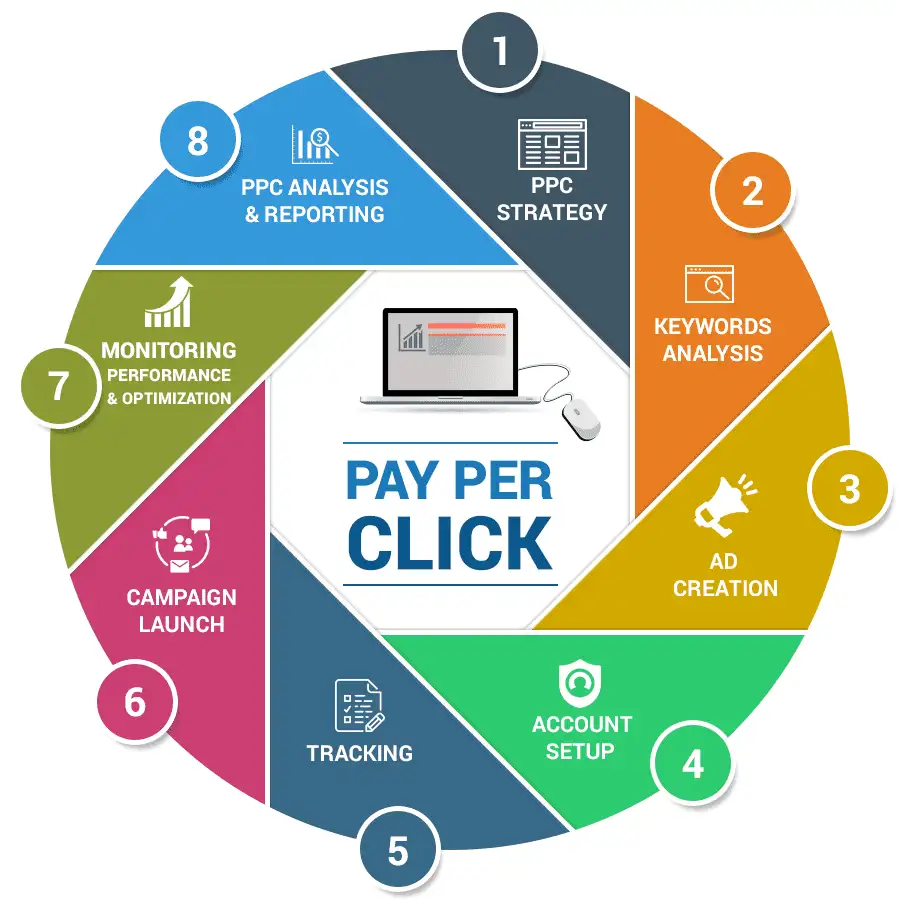
PAY PER CLICK PPC ADS
Digital advertising empowers brands by facilitating them with the opportunities to tell their stories at scale and context-wise. Marketers reach larger audiences in a real-time manner by utilizing digital tools and ads on various channels and devices.
We offer solutions to our clients’ problems and focus upon meeting their needs in a timely manner. The strategies of our campaign are sought-after in a way that works on the data drive from the market status, the trends, the competitors and the scope for the businesses.

